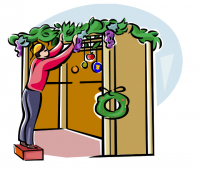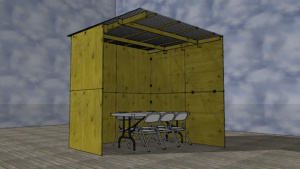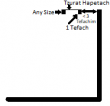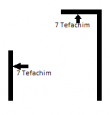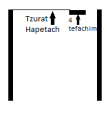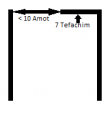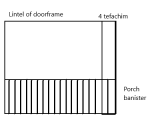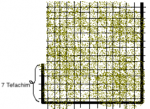Building the Sukkah
From Halachipedia
This is the approved revision of this page, as well as being the most recent.
Building the Sukkah
- One should try to begin building the Sukkah immediately after Yom Kippur, so that he is involved in one mitzvah immediately after completing another mitzvah.[1]
- One should try to personally be involved in the construction of his Sukkah.[2] If one is unable to build a Sukkah on his own and has someone else do it for him, it is proper for the builder to leave off a small amount of s'chach for the owner of the Sukkah to put up by himself.[3]
- Although it's permitted for any person to place the s'chach[4], it is preferable to be stringent and have an adult Jewish male place it on the sukkah.[5] Others hold that it is totally permitted to have women or children put up the s'chach.[6]
- When one appoints someone else to build their Sukkah, it is proper to say to them "You are my messenger to do this Mitzvah of putting up my Sukkah and s'chach for the Mitzvah".[7]
Taaseh Vilo Min Haasuy
- One should try to build the walls of the sukkah before putting up the s'chach.[8] The reason for this is because the schach needs to be put up as shade for the sukkah. If the sukkah walls weren't in place at the time, the schach doesn't function in its capacity of shade of a sukkah. After the walls are put up, some poskim hold that this is a problem of taaseh vilo min haasuy (heb. תעשה ולא מן העשוי; lit. do and don't have it made from something that was already made), the schach must be put up properly and not come out to be valid based on a later circumstance.[9]
- According to Sephardi poskim, after the fact if one put up s'chach and only afterwards filled in kosher walls, the sukkah is still kosher.[10] Ashkenazi poskim are strict and invalidate such a sukkah.[11] The way to correct such a sukkah is by taking off the schach and putting it back up after the walls were in place.[12]
- If one builds a kosher sukkah, and then the walls fall down, whether they fall before Sukkot or during Sukkot, the sukkah is still kosher when you put the walls back up, and this is not a violation of taaseh vilo min haasuy.[13] However, some poskim rule that if this occurred before Sukkot, one is required to replace the s'chach.[14]
Number of Walls of the Sukkah
- A Sukkah requires a minimum of three walls, each with a length of 7 Tefachim.[15] It's possible to build the third wall without having to complete it, but see footnote for details.[16]
Dimensions
- The minimum measure of a Sukkah is 7 Tefachim in length by 7 Tefachim in width and 10 Tefachim in height.[17] If the decorations cause the sukkah to be smaller than 7x7, it is invalid.[18]
- It is permitted to make a sukkah in different shapes, provided that it's big enough to fit a sukkah of 7 x 7 tefachim. However, according to most poskim, a sukkah which is narrower than 7 tefachim but longer than 7 tefachim (so that it's at least 49 square tefachim), is invalid.[19]
- A sukkah must be at least ten tefachim tall.[20] If a sukkah is ten tefachim tall but there are branches of s'chach hanging down within the ten tefachim, the Sukkah is invalid since it isn't fit for living. However, if there are decorations hanging from the ceiling, they are considered part of the sukkah and the sukkah is valid.[21]
- If the walls of the sukkah are 10 tefachim tall, but do not reach all the way up to the s'chach, the sukkah is kosher as long as the walls are lined up with the roof, or are within 3 tefachim of being lined up with the roof. This works based on the principle of gud asik mechitzta, which means that once you have a halakhic wall (minimum of ten tefachim), we view the walls as extending to the top and meeting the roof.[22] The walls are kosher, even if they don't touch the ground, as long as they begin within 3 tefachim of the ground. Also, even if the walls are both within 3 tefachim of the ground and don't reach the s'chach above, the Sukkah is still valid.[23]
- There is no maximum to the width or length of a Sukkah. However, the maximum height of a Sukkah is 20 Amot. If it is higher than 20 Amot then it's invalid.[24]
- If a sukkah is only 7x7 tefachim, and its height is just under 20 Amot, it is valid.[25]
- The walls of the sukkah must be built within 3 Tefachim of the ground.[26]
Arrangement of the Walls
Two L-Shaped Walls with 1 Tefach Protrusion
- It is possible to make a Sukkah with two connected walls and a third wall of slightly more than a tefach. That protrusion has to be placed at the end of slightly less than 3 tefachim from one of the walls. Then a pole that is 4 tefachim away from the 1 tefach wall and a string on top of the pole and one tefach wall to indicate that there's an appearance of a doorway (tzurat hapetach) between the wall and pole.[27]
Two L-Shaped Walls with Parallel Wall
- It is perfectly kosher to have three walls, two of which are parallel and two are adjacent in an L shape as such as long as each is 7 tefachim.[28]
Two Parallel Walls with 4 Tefach Protrusion
- If one has two walls facing one another and the third is four tefachim it must be within 3 tefachim of one side and within 3 of the other or at least have a tzurat hapetach to the second side.[29]
Two Parallel Walls with 7 Tefach Protrusion
- If the third wall is a complete wall of 7 tefachim the sukkah is valid even if it is far from the other walls.[30]
- If a Sukkah has two walls parallel to each other, it can be made kosher with a third wall that is only slightly more than 4 tefachim and is placed within 3 tefachim of one of the other walls. The Sukkah should have a tzurat hapetach (appearance of a door) connecting the 4 tefach wall with the opposite wall.[31]
- If the Sukkah has two parallel walls and a 7 tefachim or more protrusion from one side then it is valid without any tzurat hapetach. If there is a gap of more than 10 amot there should be a tzurat hapetach connecting the 7 tefachim wall with the opposite wall.[32]
- If a Sukkah has 2 walls and a third wall of 4 tefachim that needs to be completed with a tzurat hapetach, it is acceptable even if the doorframe has something in the way blocking access to actually walking through the doorframe. An example of this is with a porch that has a lintel as the doorframe connecting the 4 tefach wall to another wall and beneath the doorframe is a banister.[33] (This is assuming that the banister is not the dimensions of a wall itself.)
Completely Lavud
- Sephardim hold that one may create the walls of the sukkah by placing several poles within three tefachim of each other. This is true whether the poles are placed horizontally or vertically.[34]
- Ashkenazim only allow using lavud for all the walls if one makes 4 walls with lavud, or if one has cloth walls in addition to the 3 lavud walls.[35]
- If the walls have lavud in both the horizontal and vertical directions, it is permissible even with three walls according to everyone.[36]
Schach That Extends Beyond the Walls
- If there are 3 walls of 7 tefachim which are all attached, and one of the protruding walls is longer than the other, the s'chach that extends along that longer wall is valid and included in the sukkah.[37]
- One cannot eat nor sleep under s'chach that extends beyond the Sukkah walls, unless that area has the dimensions of a Sukkah (7x7 tefachim) and has three walls.[38]
Building a Sukkah in the street
- If there's no room on private property to build a Sukkah, it's permissible to build it in a public street, provided that the city leaders (mayor) give permission to do so. However, one should make sure that the Sukkah doesn't block walkers (traffic).[39]
Materials for walls of Sukkah
- All materials may be used for the walls of a Sukkah (see next halacha). Some say that that a pious person should preferably only use materials that aren't biblically unfit for s'chach.[40] Nonetheless, one should avoid using any material that emits a foul odor.[41]
- Accordingly, one may even form a sukkah outside of one’s car by opening the doors on one side of the car and placing s'chach over them.[42]
- Many authorities hold that plastic curtains (tarp, canvas) are unfit for walls of a Sukkah, while others permit. [This is not because of an issue with the material itself but because of an issue with it blowing in the wind.][43]
- Even though a tzurat hapetach is considered a wall for the halachos of Kilayim and Eruvin, it isn’t considered a wall for the critical walls of a Sukkah.[44]
When should one build the Sukkah?
- The pious are careful to build to begin building the Sukkah on Motzei Yom Kippur and finish it the next day in order to go from one mitzvah (Yom Kippur) to another (Sukkot).[45]
- If there is a Shabbat between Yom Kippur and Sukkot some poskim say that there is an obligation to build it before that Shabbat.[46]
- Preferably, one should build it for himself, but if this isn't possible he should appoint an agent to do it for him and strive to at least take part in the building in some form even if this means missing out on more learning time.[47]
- If a Sukkah was set up with the s'chach from before 30 days before sukkot and it wasn't made for the purpose of the mitzvah of Sukkot one must change or improve one thing (such as putting down s'chach) of an area a tefach by a tefach or the whole width even if it's of minimal length (or vice versa). However, if it was made within 30 days of Sukkot or was made for the express purpose of Sukkot it's fit even without any change. However, if the Sukkah was originally built for Sukkot and stands unchanged year to year it requires some change the each year. This is only if the s'chach was put in advance but if just the walls were put up in advance and not the s'chach there's no issue.[48]
- If one forgot intentionally or unintentionally to build a Sukkah before Sukkot one can build it on chol hamoed. One may, however, not build it or fix it on Yom Tov.[49]
- If one builds a Sukkah on Chol HaMoed, one should recite a shehechiyanu the first time one sits in the newly built Sukkah.[50]
- On Friday afternoon, ideally one should build the Sukkah before midday. However, many poskim hold that it is permissible to do so even in the afternoon until nine and a half hours into the day.[51]
Decorations of the Sukkah
- It is a mitzvah to decorate and beautify the Sukkah.[52]
- On Shabbat and Yom Tov one must ensure not to move any of the sukkah decorations because they are muktzeh.[53]
- If one needs to remove a decoration because of fear of rain or thieves on Shabbat or Yom Tov preferably one should stipulate (as above). Nonetheless, if one forgot then he may remove them.[54] On Chol Ha'moed, the decorations may always be removed even without a stipulation.[55]
- The decorations of the Sukkah are forbidden from benefit from the first day of Sukkot until after Simchat Torah unless one stipulates before Yom Tov that I want to be able to eat and get benefit from these decorations at any time during the holiday.[56] This is true about decorations on the walls as well.[57]
- If the decorations fell on Chol HaMoed one may move them and put them back up. However, one may not benefit from it (if it's food one may not eat it) unless one stipulated as above.[58]
- One who hangs hadasim or other things which smell nice in the Sukkah, is allowed to smell them and recite a bracha.[59]
- One should make sure to keep the decorations hanging from the s'chach within 4 Tefachim of the s'chach.[60] Some say that the decorations only need to begin within 4 tefachim of the s'chach.[61]
Types of Decorations
- One who makes colored paper chains as a decoration of the Sukkah should make sure that it is within 4 Tefachim of the s'chach. After the fact, it is, nonetheless, fit to sit, eat, and sleep under.[62]
- If one places an artistic covering underneath his schach within four tefachim of the schach and his intention is to beautify the sukkah the sukkah is kosher. However, if the covering is placed above the schach or if it isn’t to beautify the sukkah, the sukkah is invalid.[63]
- One must avoid writing any pesukim for the sole purpose of decorating his sukkah because it is forbidden to write pesukim unless it is a whole sefer.[64] Nonetheless, one may purchase printed pesukim to hang in his sukkah.[65]
- One who hangs pictures of rabbis in his home, are permitted to hang them in the sukkah for decorations as well.[66]
- Decorations that are really made for non-Jewish holidays, are still allowed to be used as sukkah decorations, because the designation for non-Jewish holidays alone is not of consequence (Hazmana Lav Milta Hi) [67]
Miscellaneous
- A sukkah built for sukkot is exempt from a mezuza since it is a temporary structure.[68]
- A sukkah built on a wagon, car, ship, etc. is kosher, and one who sits in it can recite the bracha of leshev basukkah even while it is moving.[69]
- Throughout the entire holiday, it is biblically forbidden to derive benefit from any of the essential materials used in building the Sukkah. Regarding these materials, a stipulation will not permit one to derive benefit from them.[70]
Covering the Sukkah in case of Rain
- It's permissible to cover the Sukkah on Shabbat and Yom Tov with a plastic tarp to prevent it from getting wet if one places the tarp directly above the s'chach and not a tefach above the s'chach and one has in mind to remove the tarp when one next uses the Sukkah for the mitzvah.[71]
Using Someone Else's Sukkah without their Permission
- One shouldn't use someone's sukkah without their permission.[72]
Fixing a Sukkah That Fell on Yom Tov
Links
- Yalkut Yosef Hilchot Sukkah (Hebrew 5776)
- Halacha liMoshe Misinai Laws in relation to the walls of a Sukkah by Rabbi Zvi Sobolofsky
- The Laws of Building a Sukka-Walls and Schach by Rabbi Zvi Sobolofsky
Sources
- ↑ Rama 624:5 and 625:1
- ↑ Rav Reuven Margolis (Nefesh Chaya 625:1) writes that even one who cannot sit in the Sukkah for whatever reason, and has no male family members that are required to sit in the Sukkah, should nonetheless have a Sukkah built to at least perform the mitzvah of "Building" a Sukkah. He cites the Gemara Makkot 8a, Shvuot 29a, and Yerushalmi Berachot 9:3 that a beracha is recited on the construction of a sukkah.
- ↑ Kaf HaChaim 625:11. See also Rabbi Eli Mansour's Dailyhalacha for a longer discussion
- ↑ Shulchan Aruch 635:1
- ↑ Kaf Hachayim 635:8, Chida in Sefer Kaf Achat 24:2
- ↑ Chazon Ovadia (Sukkot p. 64)
- ↑ Kaf HaChaim 625:11
- ↑ Rama O.C. 635:1
- ↑ Mishna Brurah 635:9
- ↑ Bach 635, Birkei Yosef 635:2, Maamar Mordechai 635:4, Moed Likol Chai 21:12, Chazon Ovadia Sukkot pg. 38. Chazon Ovadia even allows reciting a beracha on such a sukkah. However, Kaf Hachaim 635:18 quotes the dispute about this case and doesn't seem to definitely allow such a sukkah after the fact.
- ↑ Levush 638, Taz 635:4, Mishna Brurah 635:10, Hilchot Chag Bchag (1:7, p. 31)
- ↑ Kaf Hachaim 635:11
- ↑ Chazon Ovadia Sukkot pg. 40, Kaf Hachaim 635:18; Pekudat Elazer 630, Mikraei Kodesh Sukkot 1:11; Shevet Halevi 7:56 and 8:146
- ↑ Sh"t Rav Pealim OC 1:34; 3:40
- ↑ The Mishna Sukkah 2a states that a sukkah requires only three walls. The Gemara (Sukkah 6b) quotes a Tosefta (Sukkah 1:9) which records a dispute about how many walls are needed for a sukkah. The Rabbis hold that a sukkah requires two full walls and a third wall of at least a tefach, while Rabbi Shimon holds that a sukkah requires three full walls and a fourth wall of at least a tefach. The Shulchan Aruch 630:2 rules in accordance with the Rabbis. The Chaye Adam (146:3) writes that it is preferable to construct a sukkah with four complete walls, but admits that this is not required.
- ↑ Mishna Brurah 630:6 understands Shulchan Aruch 630:2 as holding that the third wall doesn't need to be a full wall of 7 Tefachim, but must nevertheless still look like a wall. It's therefore permissible to build two walls next to each other at a right angle (say one is from southwest to southeast and the other is southeast to northeast), and then a third wall (from northeast to northwest) that is slightly over one Tefach thick, and within 3 Tefachim to one of the two other walls (within 3 Tefachim of the northeast corner), and also a pole at the end of 7 Tefachim (7 Tefachim from the northeast corner) and a pole on top of the more than one tefach wall and the pole at the end of 7 Tefachim. See picture.
- ↑ Gemara Sukkah 3a, Shulchan Aruch 633:8, 634:1, Chazon Ovadia sukkot page 9.
- The Gemara records three opinions regarding the minimum area of a sukkah. Rebbe believes that the minimum area is four amot by four amot. (This is the shiur needed for the definition of a "bayit" (house) in halacha. Thus, the minimum size house needed to be obligated in mezuzah, building a fence, and tzara'at on the house, is four amot by four amot). Beit Hillel maintains that a sukkah only needs to fit one’s head and body, which is estimated to be about six by six tefachim. Beit Shammai rules that the sukkah must also be able to fit a small table, and thus must be at least seven by seven tefachim. The Gemara rules in accordance with Beit Shamai, and this is codified in the Shulchan Aruch 634:1. See Tosfot 3a s.v. di’amar for a list of six cases where the halacha is in accordance with Beit Shammai.
- ↑ Gemara 10b, Shulchan Aruch 634:3
- ↑ This issue is discussed by the Achronim. The Bach 634:2 learns from Tosfot 3a said that such a sukkah is kosher. However, the Magen Avraham 634:1 and Taz 634:1 argue that it is invalid, and think that the Bach's version of Tosfot is incorrect. From the Tosfot Rosh s.v. baneha and Tosfot Rabbenu Peretz s.v. lo, it is clear that the Magen Avraham and Taz's version of Tosfot are correct. The Mishna Brurah 634:1 writes that most Achronim agree that this sukkah is invalid. Chazon Ovadia p. 11 agrees. Shulchan Aruch 634:2 writes that one may construct a sukkah of other shapes, such as a circle, as long as a sukkah of 7x7 tefachim can fit inside it.
- ↑ Mishna (Sukkah 2a), Rambam Hilchot Sukkah 4:1, Tur and Shulchan Aruch 633:8
- ↑ Rava (Gemara Sukkah 4a) says that if there are branches hanging down into a ten tefach sukkah, it's invalid since it isn't livable. On the other hand, on 10b, the Gemara establishes that the decorations of a sukkah don't minimize its area. Shulchan Aruch 633:10 codifies this halacha. The Taz 633:10 explains that as long as the decorations don't bother you, it doesn't minimize the sukkah.
- ↑ Mishna Brurah 630:43, Chazon Ovadia Sukkot pg. 12.
- Shulchan Aruch O.C. 630:9 teaches based on the Gemara (Sukkah 16a) that the walls don’t have to reach the schach, as long as they line up within three tefachim of the schach. Mishna Brurah 630:43 and Chazon Ovadia p. 12 write that this is based on the concept of gud asik, that is, we view the walls as extending upward.
- The Gemara (Sukkah 6b) mentions that gud asik is a halacha limoshe misinai. The Gemara (Sukkah 4b) records a dispute as to whether one can build a sukkah without walls on the top of a flat roof utilizing the principle of gud asik. Rambam (Hilchot Sukkah 4:11) rules like R’ Yaakov who holds that if the schach is aligned with the walls of the house, the sukkah is valid because we view it as if the walls of the building extend upward. If the schach is not aligned with the walls of the house, the sukkah is invalid. Rosh (Sukkah 1:6) disagrees and rules like the Chachamim, that in either case the sukkah built without walls on a roof is invalid. Shulchan Aruch 630:6 quotes both opinions, but Mishna Brurah 630:30 is machmir for the Rosh.
- The question then comes up, that if we do not accept the application of gud asik in the case of the roof, then why do we accept gud asik in general, to extend the walls of a ten tefach wall up to the roof? The Steipler (Kehilot Yaakov Siman 4) suggests that it's possible that there is no requirement for the walls of a Sukkah to reach its roof. The only requirement is that you have a wall of ten tefachim, and once you have that, the Sukkah is Kosher, even though we don't view the walls as extending upwards. Therefore, the reason why the Sukkah on the roof is invalid, is because the Sukkah lacks walls, and we can't count the walls of the house, as we don't view them as extending upwards. Rav Nissim Karelitz (Chut Shani Sukkot p. 228) explains that even though the Mishna Brurah was machmir for the Rosh, that's when the sukkah itself has no walls and we want to extend the walls of the building beyond the roof. However, in this case, the sukkah itself has defined walls and we are extending them.
- Rabbi Akiva Eiger (responsa 12) questions the psak of the Shulchan Aruch based on a Ran (Sukkah 9a), who says that one cannot use lavud with another leniency. Therefore, in this case, one cannot combine both the kula of lavud as well as that of gud asik. However, the above approach of the Steipler resolves this issue. The Steipler's whole point is that once the walls are ten tefachim, that's sufficient, and you don't need to apply gud asik to view the walls as extending upwards. Since there's no need for gud asik, we can apply lavud and stil be consistent with the aforementioned Ran. See also Chazon Ish 77:7 for another solution to Rabbi Akiva Eiger’s question. Mishna Brurah 632:4 allows combining lavud and gud asik, but quotes a dispute about whether or not it's permitted to combine gud asik and dofen akuma.
- ↑ Shulchan Aruch O.C. 630:9
- ↑ Mishna Sukkah 1:1, Shulchan Aruch O.C. 633:1, 634:1. Gemara 2a-2b offers a number of reasons for the why the maximum height is 20 amot. Rabbah suggests that a person needs to be cognizant of the fact that he's in a sukkah, and if the skach is over 20 amot, then he won't be able to see it easily and maintain this awareness. R' Zera suggests that a person needs to be under the shade of the skach, and once the walls are so high that they're above 20 amot, he's under the shade of the walls, not the skach. Rava posits that once a sukkah is over 20 amot, it's a dirat keva, a permanent structure, while a sukkah needs to be a dirat aray, a temporary structure.
- ↑ Tashbetz 1:126 writes that even though according to Rabbi Zeira any sukkah in which one doesn't sit in the shade of the schach but in the shade of the walls it is invalid. He extends the idea of the gemara that if it is 4x4 amot wide and more than 20 amot tall to a sukkah that is 2x2 wide and more than 10 amot tall. In conclusion he rules that we don't follow the opinion of Rabbi Zeira.
- ↑ Shulchan Aruch 630:9, Rav Shlomo Zalman Auerbach in Halichot Shlomo (7:5, p. 100), Chazon Ovadia Sukkot pg. 12
- ↑ Shulchan Aruch O.C. 630:2
- ↑ Rama 630:3, Chut Shani p. 225. Nachalat Efraim p. 60 also writes that if the first two walls are perpendicular and meet at a corner with a third wall that's parallel to one of the first two walls and doesn't touch them is still kosher.
- ↑ Shulchan Aruch O.C. 630:3
- ↑ Chut Shani (Sukkah p. 225). Chut Shani implies that the only time that Shulchan Aruch O.C. 630:5 requires a tzurat hapetach is when there is a a third wall of a tefach that is completed by a tzurat hapetach. However, if the third wall is 7 tefachim you don't need a tzurat hapetach even if it is more than 10 amot of a break. See Mishna Brurah 630:18 who implies otherwise.
- ↑ Gemara Sukkah 7a, Shulchan Aruch O.C. 630:3. Mishna Brurah 630:15 quotes the Magen Avraham who wasn't sure if this case is effective unless it is a small Sukkah of 7 tefachim by 7 tefachim and there is no gap between the 4 tefach wall and the other parallel wall. However, he concludes that most disagree with the Magen Avraham and validate this Sukkah. Kaf HaChayim on Shulchan Arukh Orach Chayim 630:29:1 and Hilchot Chag Bchag (Sukkah 5:9 p. 119) are lenient.
- ↑ Rama O.C. 630:3, Mishna Brurah 630:18, Hilchot Chag Bchag (Sukkah 5:9 p. 119)
- ↑ Chut Shani p. 225 explains based on Chazon Ish Eruvin 70:19 that a doorframe is valid even if it isn't accessible to be used as a door because the space beneath it is cluttered since it is accessible on the other side. Even though one couldn't actually go through the door but it is seen as a door since on the inside it stands as a door.
- ↑ Kaf Hachaim 630:18 writes that one may create a sukkah with three walls by placing poles within 3 tefachim of each other, either horizontally or vertically. Chazon Ovadia pp. 5-6 agrees and thus allows building a sukkah on a porch enclosed on three sides by bars with less than three tefachim space between them.
- ↑ Rav Shlomo Zalman Auerbach in Halichot Shlomo (7:2, p. 98). However, Tosfot (Sukkah 16b s.v. bifachot) holds that one cannot create a wall completely based on lavud. In other words, one cannot make entire walls of either vertical or horizontal beams within three tefachim of each other. Magen Avraham 630:1 writes that Tosfot would validate a sukkah with walls made of only vertical or horizontal beams if the sukkah has four walls. Mishna Brurah 630:7 rules like this Magen Avraham, but in Shaar Hatziyun 630:49 he allows the use of vertical or horizontal beams to construct a three-walled sukkah when clothes are used to form the walls. In this case, even if one is strict to not use cloth, one can be lenient because the lavud walls would serve as backup if the cloth did untie. Chazon Ish 75:12 is strict even if one builds four walls with these beams, against the Magen Avraham and Mishna Brurah. Bikkurei Yakov 630:4 also disagrees with the Magen Avraham and disallows lavud walls even if there are four walls. Rav Hershel Schachter (Inyonei Succos 5781 min 36-8) explained that we follow that the Mishna Brurah that if there are four walls it is sufficient with lavud in one direction. Therefore, in the days of corona those who want to use sukkah's with no walls so that there's less of a health concern can do so with lavud of four walls.
- Chut Shani Sukkot p. 229 adds that even according to the Magen Avraham a wall of four tefachim can be joined to two L shaped walls with lavud even if there isn't four walls. Creating a wall with lavud is impermissible, but attaching walls can have lavud.
- ↑ Magen Avraham 630:1, Chut Shani Sukkot p. 229
- ↑ Shulchan Aruch O.C. 631:7, Mishna Brurah 631:15
- ↑ Sukkah 19a, Shulchan Aruch O.C. 631:6. The only nuance that it is valid once it has the dimensions of a sukkah and has three walls is that the middle wall wasn't built for the outer Sukkah, it was only built for the inner sukkah and nonetheless that is acceptable.
- ↑ Rav Shlomo Zalman Auerbach in Halichot Shlomo (7:11, pg 109)
- ↑ The Mishna Sukkah 12a declares that all materials are valid for the walls. This is also the opinion of Rabbi Meir in Gemara Sukkah 36b. Shulchan Aruch O.C. 630:1 codifies this. Interestingly, the Bach OC 630:1 writes that a pious person should be strict for the Or Zarua (Hilchot Sukkah 2:289:2 quoted by Hagahot Ashri 1:24) who holds that one should not use materials that one may not use for s'chach for the walls of the sukkah, such as materials that are susceptible to impurity. The Biur Hagra 630:1 questions the Hagahot Ashri, since the Yerushalmi he quotes as a proof, in fact says exactly the opposite. Beiur Halacha s.v. Kol quotes two reasons that a pious person should be strict only to use materials that are not unfit biblically for S'chach based on the Bach (siman 630), but quotes others who reject this stringency. See Chazon Ovadia (Sukkot 1-2) for a list of poskim as well even though he allows the use of these materials. Chazon Ovadia pp. 1-2 as well as Aruch Hashulchan 630:1-2 both say that most achronim do not hold of this stringency and allow one to use materials that are mekabel tumah for the walls.
- ↑ Rama 630:1
- ↑ R’ Moshe Heinemann permits this (http://www.jewishworldreview.com/1000/sukkah.car.html) . When building one’s sukkah in this manner he should also ensure that 1) the doors of the sukkah reach within three tefachim of the ground, to accomplish this it may help to park near the curb (see section titled “Lavud”) 2) the door on the opposite side of the car remains closed, 3) one may not use the seat of the car as one’s table even if he only plans to eat under the schach.
- ↑ Rav Ovadiah Yosef in Chazon Ovadyah (pg 1-5), Yabia Omer OC 9:59, and Yechave Daat 3:46, Rav Menashe Klein Mishnah Halachot 512, Rav Chaim Zonnenfeld in Salmat Chaim 254 and Rav Shlomo Zalman Auerbach in Halichot Shlomo (Sukkah 7:1 pg 97) hold that plastic curtains that sway in the wind even slightly are unfit for walls of a Sukkah. Rav Hershel Schachter (min 72-80) explains that even though the Chazon Ish (hilchot eruvin 13:6) was lenient, most poskim are strict. In a situation of extreme need Rav Schachter thought one could rely on the Chazon Ish to eat in such a sukkah.
Background- In Gemara Sukkah 24b, Rav Acha Bar Yaakov states that a wall that cannot stand in the wind is not considered a valid wall. The Chazon Ish (Hilchot Eruvin 13:6) suggests that a wall is not valid only if it falls or sways more than three tefachim in normal wind. However, Rav Ovadia Yosef in Chazon Ovadia pp. 1-5 and Rav Shlomo Zalman Auerbach (Halichot Shlomo Sukkah 7:1 p. 97) hold that plastic curtains that sway in the wind even slightly are unfit for walls of a Sukkah. Rav Ovadia adds, based on Shulchan Aruch 630:10, that this is true even if one ties down the ends because we are concerned that the ties will loosen and that he will not notice. Rav Moshe Feinstein in Sh”t Iggrot Moshe 5:40:2 writes that one should not misinterpret the prevalence of these canvas sukkot as an endorsement of their validity. On the other hand, some achronim (Rav Sonnenfeld, Rav Menashe Klein, and Rav Shternbuch all cited in Piskei Teshuvot 630:9) justify the common practice to use canvas Sukkot since nowadays they are put together well, so the concern of the Shulchan Aruch that the ties may become loose no longer applies.
- Rav Hershel Schachter (“Inyonei Yom Kippur VeSukkot” min 72-80) explains that even though the Chazon Ish (Hilchot Eruvin 13:6) was lenient, most poskim are strict.
- Rav Moshe Feinstein writes that if the canvas walls wouldn't move in the wind more than 3 tefachim without being tied down, then they are acceptable when they are tied down to the top and bottom of the frame. His reasoning is that Shulchan Aruch was only strict about a cloth that could become untied and sway more than 3 tefachim but if the cloth even if untied wouldn't sway more than 3 tefachim is permitted if tied. However, it still needs to be tied so that it doesn't move in a normal wind so that it is similar to an established house wall. Yet, since the Shulchan Aruch was strict about using cloths for walls of a Sukkah and the achronim don't distinguish between using different types of cloths one shouldn't use a canvas sukkah unless there's nothing else available. [It is questionable if today's canvas sukkah's would fit the standards of Rav Moshe of not swaying 3 tefachim in the wind without being tied down.]
- Hilchot Chag Bichag pp. 87-90 and Rav Menashe Klein (Mishneh Halachot 5:77) recommend, therefore, to place poles or cords horizontally across the sukkah within three tefachim of each other up to a height of ten tefachim, and, combined with the canvas, this would be a perfectly valid sukkah.
- ↑ Korban Netanel 1:8:60 quoting Ran
- ↑ Rama 624:5, Mishna Brurah 624:19, Yalkut Yosef Moadim page 118, Chazon Ovadia Sukkot page 99
- ↑ Avnei Nezer 459 writes that this obligation isn't just because of zrizin makdimin limitzvot and therefore it is an obligation. However, the Minchat Elazar 4:55 writes that this is not an obligation but just the preferred option, and this is the conclusion of Yalkut Yosef page 118 and Chazon Ovadia Sukkot page 99.
- ↑ Yalkut Yosef Moadim page 199, Chazon Ovadia Sukkot page 99
- ↑ Shulchan Aruch 636:1, Mishna Brurah 636:1, 5-7. Mishna Brurah 636:4 also points out that this is only the preferable course of action (but after the fact isn't absolutely necessary).
- ↑ Shulchan Aruch O.C. 637:1, Mishna Brurah 637:1. See Rabbi Shay Schachter in a shiur on yutorah.org who discusses the opinion of Rabbi Eliezer who wouldn't allow building a Sukkah on Chol HaMoed.
- ↑ Yalkut Yosef 637:1 and Rivevot Efraim 6:337:1. See, however, Az Nidbaru 13:39 who argues that the shehechiyanu is made upon the building the sukkah as it is a preparation for a mitzvah but once one made shehechiyanu upon the primary mitzvah, sitting in the sukkah, there is no more of a reason to recite when building a sukkah in the middle of sukkot. Yalkut Yosef Sukkah p. 487 supports this ruling from the Masat Moshe 1:5 and Mikrei Kodesh 1:25 unlike the Betzel Chachma 5:171, Shraga Hameir 5:72, and Kinyan Torah 4:76 who hold not to recite shehechiyanu in the middle of Sukkot.
- ↑ Pesachim 50b establishes that someone who works after mincha on Friday will not see any bracha to see work. Mordechai (Pesachim 5:603) quotes the Maharam who explains that it is after mincha gedola, meaning after midday, which is a half hour beforehand. However, Rashi (Pesachim 50b s.v. min) says that the gemara refers to mincha ketana, which is nine and a half hours into the day. Both opinions are cited in Shulchan Aruch O.C. 251:1. Mishna Brurah 251:2 writes that someone who is lenient doesn't lose out. The Pri Megadim E"A 625:1 writes that it is forbidden to build a sukkah after midday on Friday based on siman 251. Mishna Brurah 625:2 cites the Pri Megadim and agrees. However, the Bikkurei Yakov 625:5 disputes this because the achronim, including the Magen Avraham, Taz, and Eliya Rabba in siman 251 are lenient to follow Rashi. Therefore, he allows building the sukkah until mincha ketana.
- ↑ Gemara Shabbat 133b, Chazon Ovadyah (Sukkot pg 74). Mishna Brurah 638:11 writes that it's a mitzvah to decorate the sukkah with important fruit and clothes, however, one should not hang nice fruit if one has children and one knows that the children will rip them down and eat them. The concept of hidur mitzva, beautification of mitzvot is brought down in Shabbat 133b based on the pasuk “Zeh Eli VeAnvehu” - “This is my God and I will Beautify His Mitzvot”. The Raavad (cited in Chidushei Anshei Shem, Brachos 38a, no. 2) suggests that Hiddur Mitzvah is a biblical commandment, whereas the Ritva (Sukkah 11b s.v. Vi’ee) holds that it is only rabbinic.
- ↑ Rama 638:2, Chazon Ovadyah (Sukkot pg 83)
- ↑ Mishna Brurah 638:24, Chazon Ovadia (Sukkot pg 92), Shalmei Moed (pg 107)
- ↑ Piskei Tshuvot page 361
- ↑ Shulchan Aruch 638:2, Chazon Ovadyah (Sukkot pg 77) , mishna brura 638:2
- ↑ Although the Shulchan Aruch 638:2 writes that anything “hanging in the sukkah” is forbidden to derive benefit from, the Mishna Brurah 638:10 writes that this status also extends to other decorations hanging from the walls of the sukkah.
- ↑ Mishna Brurah 638:14, Chazon Ovadyah (Sukkot pg 83)
- ↑ Chazon Ovadia Sukkot pg. 87, Bikkurei Yaakov 638:19, Shulchan Aruch HaRav 638:5. Ritva Sukkah 37b d"h Hadas Shel Mitzva explains that even though you are not allowed to smell the hadas which you are using for the mitzva of Arbaa Minim, you are allowed to smell ones that are hanging in the sukkah.
- ↑ Rama 627:4
- ↑ Chazon Ovadyah (Sukkot pg 76) writes that it's only lechatchila to have the decorations within 4 tefachim of the s'chach. Then he says perhaps it only needs to start within 4 tefachim of the s'chach. Rav Yacov Kamenetsky in Emet LeYacov Shulchan Aruch 627 writes that the beginning of the decoration has to be within 4 tefachim of the s'chach.
- ↑ Chazon Ovadyah (Sukkot pg 76)
- ↑ Shulchan Aruch 627:4. Chazon Ovadia p. 84 writes that if one’s intention is to both beautify the sukkah and to protect oneself from the sun and rain the sukkah is kosher.
- ↑ S”A 638:2, Magen Avraham 638, Ginat Veradim OC 2:25. Rambam Hilchot Sefer Torah 7:14 and Shulchan Aruch YD 283
- ↑ Piskei Teshuvot p. 363, Chazon Ovadia Sukkot pg. 92
- ↑ Chazon Ovadia Sukkot pg. 77, Rabbi Eli Mansour
- ↑ Chazon Ovadia Sukkot pg. 77, Rabbi Eli Mansour, Shu"t Shevet Halevi 2:57, Shu"t Shevet Hakehati 2:215
- ↑ Chazon Ovadia Sukkot page 94, Shulchan Aruch YD 286:11 based on Yoma 10b.
- ↑ Yalkut Yosef Moadim page 121, Yechave Daat 3:47, Chazon Ovadia Sukkot page 169.
- ↑ Mishna Brurah 638:1 explaining Shulchan Aruch there. See Tosfot (Sukkah 9a s.v. minayin). The Rama 638:1 notes that the essential materials of the sukkah can’t be used even if makes a stipulation that they should not be designated for a mitzvah. However, one may derive benefit from the noyai sukkah, the decorations of the sukkah, if one makes a stipulation.
- ↑ Sh"t Igrot Moshe 5:39(4) writes that it's permissible to cover the Sukkah with a plastic sheet on Shabbat and Yom Tov without an issue of Boneh by making an Ohel nor the issue of muktzeh.
- ↑ Rama 637:3, Halachos of Other People's pg. 67
- Mishna Brura 637:9 quotes the Taz 637:4 that the reason for this is that it would be an invasion of the owner's privacy
- Mishna Brura 637:9 quotes Eliya Rabba 637:3 who explains that you might not finish eating before the owner wants to enter, and the owner will be too embarrassed to ask you to leave
- Mekor Chaim 637 says because you might leave a mess.
- Halachos of Other People's Money pg. 68 note 184 writes that the practical difference between these reasons is that according to the first two, one who is certain that the owner is not around would be permitted to use it, but he would not be allowed to use it according to the third reason.
- ↑ Yabia Omer OC 8:50, Rivevot Efraim 1:424:1
